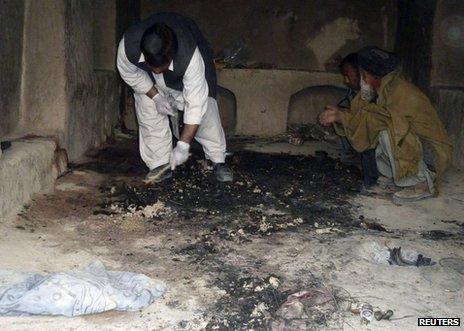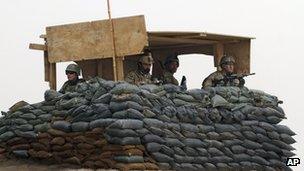How it happened: Massacre in Kandahar
- Published

Ashes and what appeared to be bloodstains could be seen inside one of the houses attacked
In the pre-dawn hours of Sunday, a US soldier stationed at a base in Afghanistan's Kandahar province allegedly launched a single-handed gun attack on nearby Afghan villagers.
The soldier, who was later named as Staff Sgt Robert Bales, is said to have broken into three homes in three different locations in Panjwai district - the villages of Alkozai and Najeeban and another settlement known locally as "Ibrahim Khan Houses".
Details are still emerging about the exact sequence of events after he left his base in Panjwai.
But by the end of the attack, 16 people, nine of them children, were dead and five wounded. Some of the bodies had been set on fire. The killings have devastated these remote farming communities.
Timings?
Initial reports said that Sgt Bales simply walked to the villages, which were located about 500 (546 yds) from the military base in Panjwai district.
But local journalists say that the villages of Najeeban and Alkozai are about 5-7km (3-4 miles) apart. This immediately raises questions about accounts which said he completed his deadly circuit on foot.
An Afghan guard at the Nato base told the BBC that Sgt Bales left the base twice. He returned at 00:30 local time (20:00 GMT) after the first trip out and was out between 02:00 and 04:00 for the second trip.

Witness accounts from people in the villages paint a chilling picture with curious and sometimes contradictory features.
In one village Sgt Bales reportedly went from house to house, trying the handles of several doors and entering the homes and killing those whose doors were unlocked.
Many of the villagers are not permitted to leave their houses at night, so the sense of fear was particularly acute.
"When it was happening... we were inside our houses," one villager said. "I heard gunshots and then silence and then gunshots again," resident Abdul Baqi told the Associated Press news agency
A woman in one of the targeted villages told the BBC she first heard helicopters at 02:00 and then gunfire. Others said helicopters and gunfire could be heard from midnight.
It is unclear if extra troops had been sent out after the attacks to apprehend the gunman.
Some villagers say that helicopters were flying overhead as the killings took place. Many locals appear to believe that they were in fact supporting the operation rather than trying to stop the gunman.
But correspondents say helicopters are frequently heard overhead in parts of the country.
'Pretending to be dead'
There appear to be few witnesses who actually saw the attacker.
Mohammad Zahir, told the AP news agency how he watched the soldier moving through his house apparently searching for something and shooting at his father when he emerged from a room to investigate the disturbance.
Another eyewitness, 20-year-old Jan Agha, told Reuters he had been woken by gunfire along with his father, who peeped nervously outside through a curtain.
Suddenly more shots were fired and his father fell dead, hit in the throat and face. Also killed were Mr Agha's mother, brother and sister.
The young man said he had survived by lying on the floor, pretending to be dead.
Speaking through tears, a grandfather, Samad Khan, told Reuters news agency that 11 members of his family had been killed, including his children and grandchildren.
The farmer, who had been away from the village when the attack happened, said he believed that chemicals had been poured over the bodies and set alight.
Photographs show at least one child's body partially charred, while a pile of ashes lay on the floor of a room in one of the houses with what appeared to be bloodstains close by.
Images of the bodies also suggest that at least some were killed by a single shot to the head.
Was he alone?
American military officials say that the suspect - who was wearing night vision goggles - acted alone before surrendering.

The base in Panjwai is heavily guarded by both Afghan and US soldiers
Some survivors of the attack believed that more than one soldier was involved. But Afghan officials, who intially considered this theory, now say it is likely only one attacker was responsible.
Nato officials have consistently maintained that there was only one killer.
Sgt Bales was working alongside special forces as force protection. Part of his role was to guard the base for special forces, which would have enabled him to come and go more easily. He had not had special forces training.
The Afghan guard at the base told a BBC reporter that when the soldier returned to the base after the first trip out, he greeted them in rudimentary Pashto.
Intelligence sources in Kandahar have confirmed that some troops stationed at that base were involved in ongoing negotiations with locals trying to convince them to return to their villages, after the Taliban were cleared from the immediate area.
Sgt Bales is 38, married with two children.
He had served three tours of duty in Iraq - being deployed to Afghanistan for the first time in December - and has served in the army for 11 years.